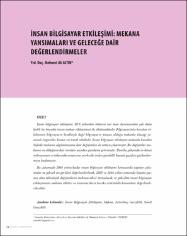İnsan Bilgisayar Etkileşimi: Mekana Yansımaları ve Geleceğe Dair Değerlendirmeler
Abstract
İnsan bilgisayar etkileşimi, 80'li yıllardan itibaren var olan durumundan çok daha farklı bir boyutta insan mekan etkileşimini de etkilemektedir. Bilgisayarlarla kurulan etkileşimin bilgisayarın kendisiyle değil bilgisayarın parçası olduğu mekanla olacağı yönünde öngörüler bunun en temel sebebidir. İnsan bilgisayar etkileşimi mekanla kurulan ilişkide mekanın algılanmasına dair değişimleri de ortaya çıkarmıştır. Bu değişimler mekanın ne olduğuna dair soruları yeniden gündeme getirmiştir. Tüm bu gelişmelerin ikinci milenyumun ortalarında araştırma merkezlerinden gündelik hayata geçişleri gözlemlenmeye başlamıştır.Bu çalışmada 2005 yılına kadar insan bilgisayar etkileşimi konusunda yapılan çalışmalar ve gelecek ön görüleri değerlendirilerek, 2005 ve 2016 yılları arasında hayata geçmiş olan teknolojik değişimlerin mekana etkisi tartışılacak ve gelecekte insan bilgisayar etkileşiminin mekana etkileri ve tasarımcıların bu eko sistemdeki konumları değerlendirilecektir Human computer intearction is affecting space in a more different dimension than its existing condition. The main reason for this is the preassumptions made for the interaction with computers will be rather than itself, with space it belongs to. Human computer interaction also reveals the changes in perception of space while interacting with space via computers. These changes resurrect the quetion that what the space is. Most of these developments are occured in the first decade of second millenium while most of the researches in laboratories are carried out in daily life.In this paper, human computer interaction studies up to 2005 and the assumptons for future developments will be evaluated. Realized developments in daily life from 2005 to 2016 will be discussed in a focus of tehe relation between space. Future effects of human computer interaction on space and the position of designers in this eco-system will be evaluated
Source
Sanat & Tasarım DergisiVolume
6Issue
2URI
http://www.trdizin.gov.tr/publication/paper/detail/TWpZd01qa3pNdz09https://hdl.handle.net/11421/19721


















